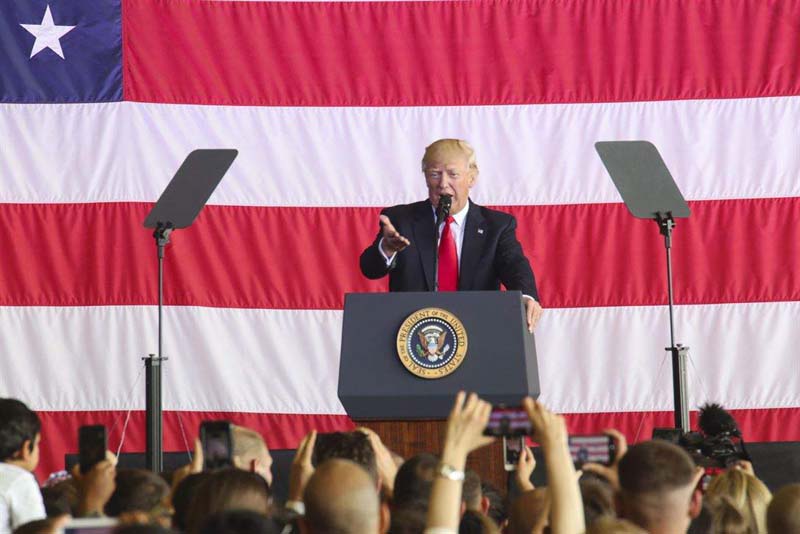{Originally posted to the BESA website}
“Trumpism”
‘);
_avp.push({ tagid: article_top_ad_tagid, alias: ‘/’, type: ‘banner’, zid: ThisAdID, pid: 16, onscroll: 0 });
Trumpism is a phenomenon of unprecedented populist presidential behavior. Trump is the least presidential president in modern history. Never have so many critical books been written about a US president during the first two or three years of his tenure. They addressed his problematic personality and careless work habits as well as his cavalier treatment of employees at the White House and in key institutions such as Congress, the judiciary, and the media. He has set records for ousting senior government officials, usually because of their inability to work with him or support his policies. He makes decisions in a scattershot and superficial fashion without consulting bodies such as the National Security Council and the intelligence agencies. He often uses Twitter to convey messages, including on sensitive foreign and defense issues, in an unprecedented form of online diplomacy. He greatly exaggerates his own achievements and frequently raises the concept of “fake news.” He has brutally attacked the media, calling them “enemies of the people.”
Trump benefits from a solid conservative constituency amounting to 40% of the voting public, which includes conservative whites, factory workers, uneducated voters, Evangelical Christians, and residents of rural areas. During his tenure he has made great efforts to implement his campaign promises and preserve this base of support.
The Democrats claim Trump is tarnishing the institution of the presidency and has committed violations of the law grave enough to warrant impeachment. In all of American history there have been only two impeachment proceedings for a serving president. Both failed because conviction requires a two-thirds majority in the Senate—a majority the Democrats do not have.
It is not clear whether the impeachment process will hurt or help Trump’s chances to win a second term. The 2020 elections will determine to what extent Trumpism is a passing phenomenon or a deeper trend in American society. The election results will be even more consequential if either or both of the Democratic presidential and VP candidates is a figure who, like Senator Elizabeth Warren, represents the more radical wing of the Democratic Party.
Deep polarization
The Democratic Party has been moving left since this century began. The trend was reinforced with the election of Barack Obama and the passing of the Affordable Care Act, which was unprecedented in American history. Conservative Republicans saw the Act as a first step toward turning the US into a socialist country and made a great effort to thwart it. Another, more populist reaction was the formation of the Tea Party movement, which took the Republicans further to the right. In the Democratic primaries for the 2016 presidential elections, elderly socialist Bernie Sanders significantly weakened the status of establishment candidate Hillary Clinton and was able to draw considerable numbers of young people into his camp.
In the 2018 congressional elections, four young, radical Democratic women won seats in the House of Representatives: two Muslims (Ilhan Omar of Somali background and Rashida Tlaib of Palestinian background), Alexandria Ocasio-Cortez (of Hispanic origin), and an African American (Ayanna Pressley). They forged a kind of coalition of minorities, “the Squad,” which is challenging the party’s moderate leadership in an effort to push it more to the left. Two of the Democrats’ three leading contenders for the 2020 presidential nomination, Bernie Sanders and Elizabeth Warren, belong to the radical wing.
These developments testify to a movement by the Democratic Party toward the far left—a shift that has not, at this stage, won the sympathy of the general public.
This leftward shift by the Democrats has contributed to a rightward drift among Republicans. The American system of government is built on checks and balances, moderation, and compromise between parties and authorities. Over the past decade, these features have largely disappeared, and a profound polarization, acrimony, and hatred have emerged in American society the likes of which have not been seen since the Vietnam War or even, according to some, the Civil War. The 2020 presidential and congressional elections will indicate whether this polarization will continue and perhaps intensify in the coming decade or whether leaders will be elected who will put a halt to it and restore balance to the political system. As of this writing, it appears the elections will deepen the rifts in American society and this process will continue into the coming decade.
Demographics
Demographic changes in the US will gain steam over the next decade. Whites will lose a considerable proportion of their share of the population while minorities, particularly Hispanics (Americans whose origins are in the Latin American countries), will increase their share.
Ethnic groups in the American population
| Groups | 2010 | 2020 (estimate) | 2050 (estimate) |
| Whites | 65.2% | 62% | 47% |
| Hispanics | 16.3% | 18% | 29% |
| African Americans | 12.6% | 13% | 14% |
| Asians | 4.8% | 6% | 9% |
Sources: US Census Bureau, Pew Research Center, UN Department of Economic and Social Affairs
The percentages of whites in American society will decline consistently. At mid-century they will still be the largest demographic group, but they will lose the decisive majority they have known since the founding of the US, constituting only about 47%. The Hispanic demographic is growing the fastest, and by 2050 will not be far from doubling its current strength to about 29% of US society. The share of Asians will also grow considerably to reach about 9%. In some states, such as California—the most populous in the country, with about 40 million residents—whites are already a minority (they represent 38% of California’s population). Hispanics also amount to 38% there, while Asians constitute 15% and African Americans 6%.
In the coming decade these demographic changes will have far-reaching consequences in all areas of politics, society, and the economy. By building coalitions, minority groups could assume control of American politics on both the national and state level.
Minority groups have traditionally supported the Democratic Party, which has been attentive to their needs. That, however, is one of the reasons for Trump’s victory in the 2016 presidential election. He represents a white America that is struggling to maintain its status in American society. Trump has worked hard to stop illegal immigration, primarily from Latin America, and has accused the Democrats of opposing any limits on immigration and of impeding construction of the wall along the US-Mexican border because they want to bolster their political base through immigration.
Economy and finance
Trump is a businessman, and for him a thriving economy is perhaps more important than any other issue. He has put great effort into revamping American industry, which lost numerous factories to countries where manpower is cheap. He has waged fights to modify trade agreements with countries he believes have caused harm to the American economy, including China.
The American economy is the largest in the world. Although the population accounts for only 5% of the global population, it produces 20% of the world’s revenues. In recent years all indexes have pointed to a strong economy: GNP growth stands at 2%, unemployment is at its lowest in 50 years (3.5%), interest and inflation rates are low, and the capital markets have set new records. At the same time, the national debt reached $20 trillion for the first time in history and the trade war with China triggered wide fluctuations, particularly in the capital markets.
The forecast for the coming years is not as good. Results for the last quarter of the decade show a slowing of growth and a decline in the main indexes. Trump will, however, try hard to sustain the thriving economy in the election year, as it is a serving president’s strongest card. That is the main reason why he is easing off on the trade war with China and holding talks to reach agreements that will benefit both sides. In the year following the elections, a slowdown is nevertheless anticipated, with output growing at less than 2%.
If Trump wins, he is likely to continue current policy. If the Democrats win, they will probably try to make substantial changes in the budget including a tax increase and large allocations for welfare, the environment, education, and health. Because it is Congress that approves budgets, the administration’s ability to conduct an economic policy will depend in part on who gains control of the two houses.
Foreign relations
The twentieth century is known as the American century because it turned the US into the largest, most important, and most influential superpower in the world. The US led the way to decisive victories in three wars: World Wars I and II and the Cold War, which lasted for almost the entire second half of the century. The American withdrawal from international affairs between the two world wars contributed to the outbreak of WWII and proved how essential the US is to maintaining peace and security in the world. It became the “world’s policeman,” a role it took upon itself.
In that regard Obama and Trump hold the same view: that that global role should come to an end. Obama began a process of disengagement, preferring collaboration with international organizations such as the UN, other powers such as Germany, Britain, and France, and multilateral diplomacy, such as the process that produced the nuclear agreement with Iran. Trump has continued this trend but without turning to international organizations, which he has accused of corruption, inefficiency, and opposition to American values.
Trump’s 2016 campaign slogan “America first” signaled a desire to focus on domestic issues. It is still too early to say whether the international system will shift to a multi-power framework that will include the US, China, Russia, and the EU. But the trend in the US of partial isolationism appears to be entrenched. It stems primarily from the US’s protracted failed wars in Afghanistan and Iraq and from the economic burden of acting as the world’s policeman.
The US has always opposed nuclear proliferation, particularly when it would enable dictatorships to obtain nuclear weapons and means of delivery such as intercontinental missiles, yet neither Obama nor his predecessors succeeded in halting the construction of North Korea’s nuclear infrastructure. Obama thought he could stop Iran’s race to the bomb with an international agreement.
Trump has met with North Korean ruler Kim Jong-un three times and promised him sizable economic assistance in return for dismantling his nuclear arsenal. Kim has indeed put a halt to experiments with intercontinental missiles, but despite optimistic declarations is not prepared for disarmament.
Trump labeled the nuclear deal with Iran the worst in American history, withdrew the US from it, and imposed heavy sanctions on Iran. Iran, in turn, renewed its nuclear activity, the outcome of which can only be nuclear bombs. With both Obama and Trump having declared that they will not allow Iran to go nuclear, this issue will occupy the US in the coming decade.
Relations with Israel
Benjamin Netanyahu has called Trump the best friend Israel ever had in the White House. The president has indeed made historic decisions on issues important to Israel, such as transferring the US embassy from Tel Aviv to Jerusalem, recognizing Israeli sovereignty on the Golan Heights, affirming that the settlements do not necessarily violate international law, withdrawing from the nuclear agreement with Iran, and levying harsh sanctions on Iran. Trump has also fought hard at the UN against one-sided anti-Israeli resolutions, accused the Palestinians of failing to show up for peace negotiations, suspended funding of the Palestinian Authority and UNRWA, and closed the PLO office in Washington. He formulated an Israeli-Palestinian peace settlement he calls the “Deal of the Century,” though he has only revealed its economic part so far.
On the other hand, the pulling of US forces out of northern Syria and abandonment of the Kurdish fighters, the lack of any response to the downing of an American drone by Iran or to the attack on the Saudi oil facilities, and the effort to meet with President Rouhani at almost any price have prompted concern about the stability of Trump’s Middle East policy.
The Democrats’ leftward drift alongside Netanyahu’s ever-closer relations with Trump and the Republicans have fostered alienation between Israel and the Democrats and between Israel and American Jewry, most of whom support the Democrats. Presidential candidates of the radical wing have announced that they may use aid to Israel to pressure Jerusalem to change its policy in the territories and toward the Palestinians. If the Democratic candidate is elected president and the Democrats take control of Congress while the government in Israel does not change, the new US administration is likely to get tough toward Israel and revert to patterns that prevailed in the Obama period. Because demographic changes are likely to work in the Democrats’ favor, any new government in Israel will have to rehabilitate relations with them and with American Jewry as well.
(Prof. Eytan Gilboa is senior fellow at the USC Center on Public Diplomacy in Los Angeles and a senior research associate at the BESA Center for Strategic Studies)
‘);
_avp.push({ tagid: article_top_ad_tagid, alias: ‘/’, type: ‘banner’, zid: ThisAdID, pid: 16, onscroll: 10 });




